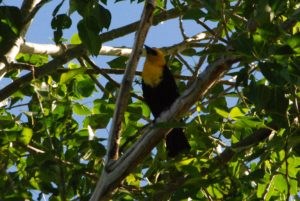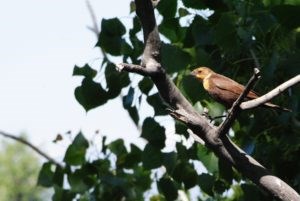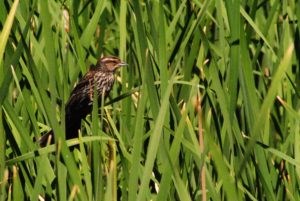This content was originally published by the Longmont Observer and is licensed under a Creative Commons license.
Having spent time in Louisiana in rice fields doing research, I was quite familiar with the red-winged blackbird and the songs it sings. But one year I was doing a field study on Canada geese in Colorado when the peacefulness of the study site was shattered by the most raucous screech I’d ever heard. Turns out it was a yellow-headed blackbird which I had never seen up until this point. Now I see them breeding out at Jim Hamm on a regular basis.

In contrast to the yellow-headed blackbirds, red-winged blackbirds (or tricolored blackbirds as they are also called) are smaller in size. They are all black with the exception of red and yellow shoulder patches, also known as epaulets. Females are dark brown with prominent streaking and may have a white eyebrow.
Breeding occurs in wetlands, although the red-winged blackbird may also sometimes breed in meadows and undisturbed fields. The yellow-headed blackbird and red-winged blackbird will nest in the same marshes, but the yellow-headed blackbird will occupy the most preferred nesting spots because it is larger. Nesting often occurs in cattails, bulrushes, or reeds.
Males of both species will sing and display to attract females. Male yellow-headed blackbirds will chase potential female mates, grabbing the female’s rump with their bills. At this point, the pair will fall into vegetation where the male lets go of the female. Red-winged blackbirds have a similar display. Male red-wings will also sit high on marsh vegetation singing repeatedly and spreading their wings to show off their shoulder patches. Many times, they will also lower and spread their tail as well. Similarly, male yellow-headed blackbirds will sit on high perches such as bare tree branches that overhang the marsh, and point their beak to the sky while calling and spreading their tail feathers.
Yellow-headed blackbirds may have up to eight females on their territories while red-winged blackbirds may have up to 15. However, anywhere from one quarter to one half of nestlings were fathered by a male other than the male where the nest is located. This is true for both species.


Catching a glimpse of these birds can range from easy to difficult, but as with all birdwatching, patience is rewarded. As I mentioned, Jim Hamm seems to be a good place to see both species as there is a cattail marsh along the edges of the pond. Yellow-headed blackbirds are more common here, so you may have more trouble finding the red-winged blackbird. However, the cattail marsh at the Longmont Recreational Center is host to numerous red-winged blackbirds.
The best times to spot these birds is early morning or late afternoon. Males will be much easier to spot than the females. Often, you will hear the birds before seeing them. Red-winged blackbirds make a conk-a-ree sound which is perhaps the most distinctive sound made by these birds. They do have other calls as well, but locating this particular sound is likely to lead you to sighting a male of the species. Female red-wings tend to stay close to the ground and are therefore harder to spot. Male yellow-headed blackbirds make a screeching sound, often likened to the sound of a door swinging on rusty hinges. Females of this species also tend to stay low in the marsh. Next time you are out near a cattail marsh, look for these beautiful birds.
The Longmont Weekly Wild is a weekly column about all things wildlife and wild in Longmont. You can find previous articles under the Lifestyle section.


